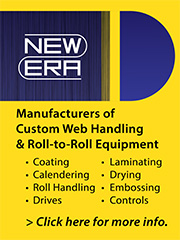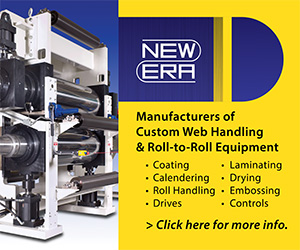The Miracle of Coextrusion Makes Believers of Many
- Published: September 01, 2001, By David J. Bentley, Jr., RBS Technologies
Coextrusion… has allowed converters to make different constructions using alternate materials for new applications.
Since its introduction only a few decades ago, coextrusion of polymers has become something of a miracle in the plastics industry, solving many problems that would otherwise plague various segments of the converting fields today.
Consider the blow molding of containers. The number of products available in these containers today seems unlimited. An important reason why suppliers can offer so many different materials in molded plastic containers is the ability to customize the container through judicious blends of materials combined through coextrusion.
For example, the inside wall of a plastic container can be a plastic that is very resistant to the contents of the package, while the outside can be a plastic that provides excellent appearance and printability.
While the container in this example involves coextrusion of only two layers, many layers are possible. A good example of three layers would be a blow molded container for use with in-mold label applications. The inside and outside layers might be virgin polymer. Sandwiched between these layers would be a layer of coextruded material that would be reground scrap or reject from the in-mold label operation. It could contain bits of paper labels and other items that would make it unattractive, but the consumer will never know it is present since it is sandwiched between the two layers of virgin plastic. This is an excellent way to recycle in an in-mold label operation.
Coextrusion is also important in the flexible packaging area and has allowed converters to make different constructions using alternate materials for new applications.
Flexible packaging involves the combination of two or more substrates customized according to the final needs of the package.
Certain packages require excellent graphics, strength properties, barrier characteristics, etc. Judicious choice of plastic films combined in an adhesive or extrusion coating operation provides the results needed. Coextrusion simplifies this considerably.
To prepare a flexible packaging material using coextrusion, one must decide only which polymers are necessary and then combine them in the correct order to obtain the progression of layers desired. The coextrusion process has an added advantage in that it can provide many layers in one operation, sometimes as many as six or eight.
Considering a three-layer coextruded film similar to the blow molded bottle mentioned above, an inner film layer might provide certain barrier properties. The middle layer of polymer could provide the necessary strength or stiffness to the final construction. A third layer on the outside might provide a surface that would be suitable for printing.
One possible disadvantage with coextrusion is that the final construction cannot contain locked-in printing. To print the inside of a multiple flexible substrate construction, one must use adhesive laminating or extrusion coating.
Some polymers undergoing coextrusion will not adhere well to other polymers. In this case, one must use a tie layer to promote proper adhesion. This is basically another extrudate in a very thin layer between two polymer layers.
Coextrusion products for flexible packaging that will contain food must meet the applicable food packaging regulations. When a layer close to the food acts as a barrier, use of other layers that do not meet the regulations may be possible. This is a special case and requires careful attention to the regulations on types of food, conditions of use, and the specific construction. Testing under rigorous conditions may be necessary to prove that a layer in the construction does indeed act as a barrier to prevent migration of any component into the packaged food.
Finally, coextrusion allows converters to make a package without the need to invest in adhesive coating or extrusion coating machinery. They simply can use the coextruded product as purchased from a supplier.
David J. Bentley Jr. is a recognized industry expert in polymers, laminations, and coatings with more than 30 years of experience in R&D and technical service. Contact him at e-mail: dbentley@unm.edu.







